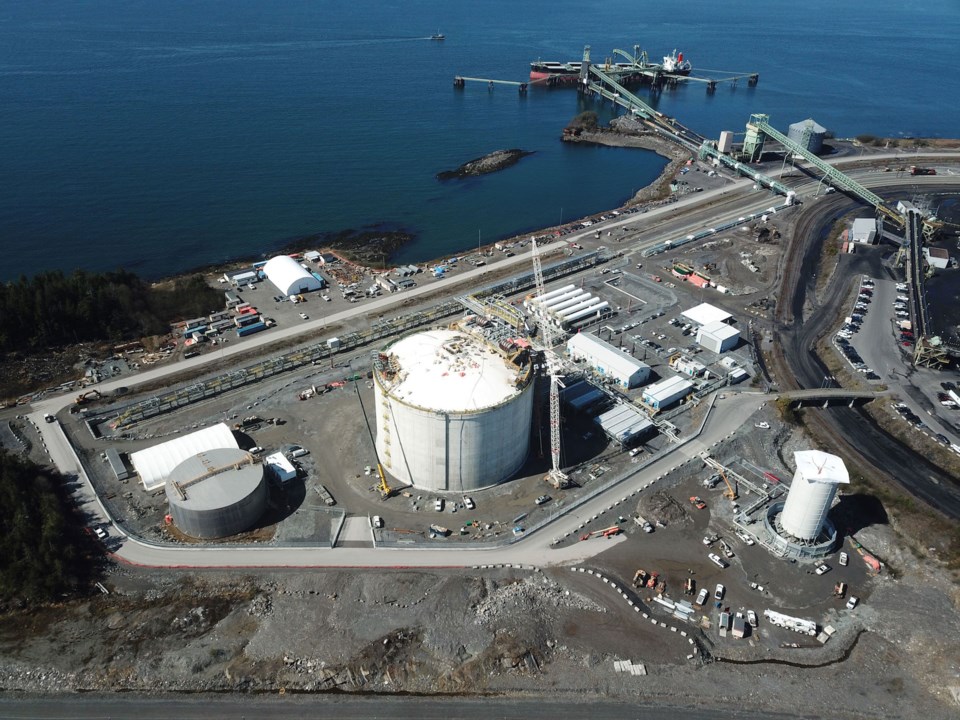Timothy Egan, president of the Canadian Gas Association, said his association has forwarded a list of 70 natural gas related projects, worth a total of $12 billion, to the federal government that are “shovel-ready projects that could help trigger fast economic returns.”
They include infrastructure projects (pipelines, gas processing, etc.), transportation, LNG projects, green retrofits, and renewable gas proposals.
“Roughly half of them – or $ 6 billion worth -- are in B.C.,” Egan said.
Canadian producers say natural gas and LNG from B.C. should command a green premium, since it has a lower carbon intensity.
For one thing, regulations in B.C. limit the use of flaring and venting, and it is implementing regulations to further reduce methane emissions from production by 45 per cent.
The B.C. government has been investing in new transmission lines to deliver power to northeastern B.C., which has allowed natural gas plants and pipelines that would otherwise burn natural gas to convert to clean hydro power.
And companies like Shell Canada have taken an approach to building pipelines and drilling wells that also avoids emissions.
“We pre-build our pipelines,” said Kim Code, vice president of upstream operations for Shell Canada. ”That reduces the flaring that would otherwise have happened.”
Shell Canada also uses recycled water for its fracking operations, which is delivered from – and returned to -- holding ponds via water pipelines, which reduces the use of trucks.
“Because we also pre-build our water pipelines, that also means that, whereas … if we didn't have pipelines built, we would have trucks on the road,” Code said.
Pacific Canbriam Energy also uses recycled water for its fracking operations.
“Our entire field is pipeline connected, taking all the water trucks off the road,” said Donna Phillips, executive vice president of corporate development for Pacific Canbriam.
“In addition to the water trucks, we have eliminated trucking of natural gas liquids through the construction of a natural gas liquids pipeline.”
In 2020, all of the water used in Pacific Canbriam’s fracking operations was recycled, Phillips said.
Gas drill count up
The number of new B.C. natural gas wells drilled in 2020 by Tourmaline Oil Corp., one of the biggest operators in the B.C. Montney region, was slightly higher than in 2019, according to the BC Oil and Gas Commission.
“We had no layoffs, and we were employing a lot of service sector employees back in the basin, as we call it, in the smaller towns like Dawson Creek and Fort St. John and Hinton and Edson,” Tourmaline CEO Mike Rose said January 28 in a session on the upstream oil and gas sector at the BC Natural Resources Forum.
Between 2013 and 2018, Tourmaline has reduced the CO2 intensity of its operations by 46 per cent, Rose said, and has plans for further reductions in both CO2 and methane from its operations over the next five years.
“Our goal is a 25 per cent further reduction over those next five years,” he said.
One area the company is now focusing on is converting all of its drill rigs and completion operations from diesel to natural gas, which will achieve further reductions, both in emissions and costs.
“It generates a meaningful CO2 reduction, as well as associated compounds that are created when you burn diesel, but also reduces our costs, after we pay out our capital investments,” Rose said. “So shareholders get a double win. They get a net cleaner methane molecule and they get a more profitable company.”
He added that if the whole sector converted from diesel to natural gas, the emissions reductions would be “enormous.”
Global export expansion
Ultimately, he thinks B.C.’s natural gas sector has a bright future.
“Any worldwide demand projection that you look at -- even those with the most aggressive renewables build out -- natural gas is the largest component of the energy stack for several decades to come,” Rose said.
“It's also the most affordable in that energy stack. For Canada, with its ever-cleaner methane molecules, we should be providing as much of the world's growing (natural) gas requirements as possible.”
Big players are betting on it.
AltaGas Ltd. built a propane export terminal in Prince Rupert, and Royal Vopak is expected to soon make a final investment decision on a new bulk liquids terminal in Prince Rupert as well that would store and export propane, as well as other liquids.
And, of course, all that “dry” gas that is the byproduct of natural gas liquids production in B.C. will also soon have a new market in Asia, in the form of liquefied natural gas. The $40 billion investment being made by LNG Canada is the largest private investment ever made in Canada to date.
A recent Canadian Energy Regulator (CER) forecast the shift away from coal and oil is expected to increase the global demand for natural gas, since it is the lower-carbon energy source of choice for the firm power needed to backstop intermittent wind and solar power.
The CER used two scenarios in its modelling, including one in which Canada and other countries increased efforts to decarbonize and shift away from oil.
“Under both scenarios, B.C. continues to have strong natural gas production growth and will, in fact, become the largest natural gas producer in Canada by 2040,” said Gitane De Silva, tCER’s chief executive officer.
Alberta is currently the largest natural gas producer in Canada.
“Our projections see B.C. natural gas production being driven by liquids production, as well as LNG export assumptions,” De Silva said. “So we see natural gas as extremely important to Canada's economic energy recovery, and it will only increase in importance over the next 30 years.”



